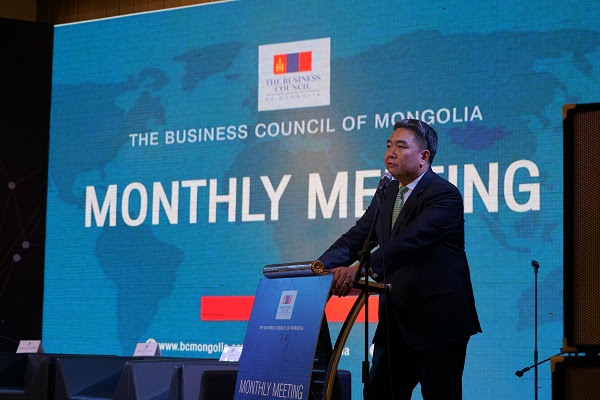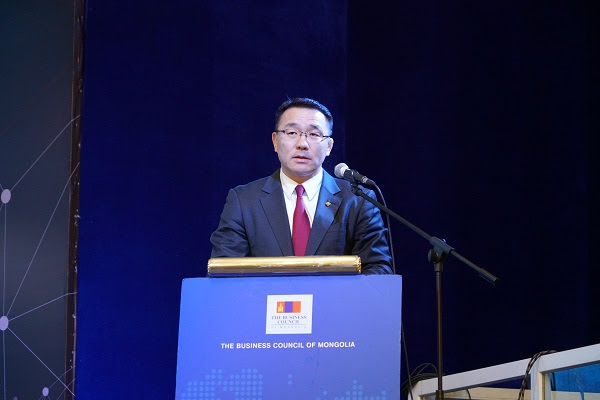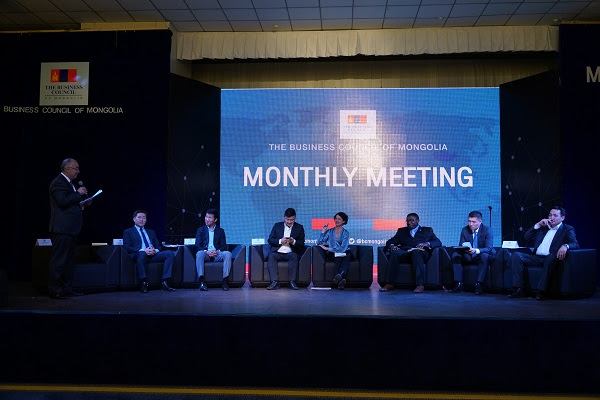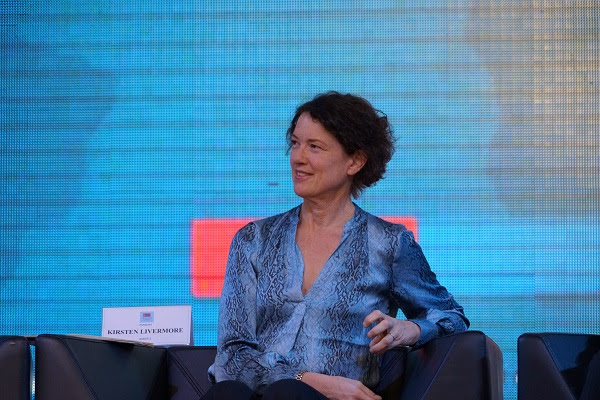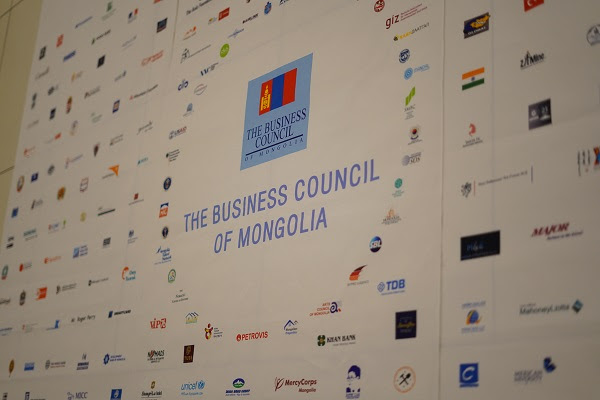DIGITAL TRANSFORMATION IN MONGOLIA
The first session of the conference saw presenters speak on digital transformation in government, the new era of AI, and digital literacy in Mongolia.
Digital Transformation in government

Presentation not available to the public
Mr. B.Batjargal, Vice Director of the Mongolian National Data Center, gave a presentation of what kinds of activities have been happening when it comes to digital transformation in government.
The government is striving to improve public services for citizens and businesses. At the one-stop service center of UB, about half of services delivered concern capital city registration.
Another initiative that people may be familiar with is the ATM-like document procurement machines seen around major city hubs, such as the central post office. Here citizens can get birth certificates, various forms of ID, etc. without going to an office.
A comprehensive transition requires infrastructure first and foremost. Then you need the digital ecosystem. Third, there is the question of information security.
The National Data Center was established in 2009 by the government. In 2019, a Disaster Recovery Center subdivision was established.
Regarding the regulatory environment, three key policies are in place.
Before the current base system, there was no unified standard for exchange of information, and government bodies would exchange information freely in whatever form or method they desired.
Regarding cybercrime, Mr. Batjargal stated that we are currently in the 5th generation of cybercrime, the “mega” era. There have been several occasions where government organizations, the military, and even Khaan Quest proponents were hacked. Out of 183 million daily requests for information exchange, about 3 million are malicious.
New Era of AI

Presentation not available to the public
Gabit Bazar is the Founder and Chairman of Infinite Solutions LLC, an IT solution provider and investment venture with a focus in fintech, and enterprise software solutions. He has launched successful startups in Silicon Valley, Denver, and New York. He also co-founded Nest High School, a new school with a special curriculum in IT and tech.
Perhaps the breakthrough moment and the real beginning of AI was the IBM-created AI Deep Blue beating chess grandmaster Gary Kasparov in a game of chess.
“Deep learning” seeks to emulate the neural connections of a brain, in that it can process data and “learn” from that data, altering its own decision-making algorithms to be better or more accurate or more befitting of a situation in the future.
There are a couple limitations to AI: massive amounts of data, super computer power, top AI scientists, and singular defined domain.
In July 2016, the Google Home’s speech recognition error rate was 8.5% percent. In less than one year, in May 2017, this rate had fallen to 4.9%. Megvii Technology’s Face++ application used in China can recognize 3 million faces in one second. In 2012, self-driving cars made 1 error per second. In 2017, they had an average error rate of 1 error per year.
Some threats presented by AI include job replacements and the question of whether a fair, shared economy can be realized. AI will replace the majority of workers in entire industries. Mechanical, repetitive, and physical jobs are more at risk than creative professions.
Even jobs that require a human touch, such as teachers and doctors, will work in conjunction with AI. Research that takes months may be conducted nearly instantaneously.
What does Mongolia need to do? Update its educational system. Collaborate: don’t hog data. Learn from the best.
In the past, the goal of education was getting good grades, to get a good job, and start a family, etc. Today, we must emphasize skill sets over grades, spend quality time, and work with time.
It’s not about regurgitating texts and formulas, but solving complex issues that require interrelated skill sets and personal attributes: “learn how to learn.” It’s not about just having a good job, but working with passion. It’s not just about starting a family, but spending quality time with them.
Digital Literacy in Mongolia

Click here to view presentation
Ms. A.Byambajargal is the Founder of the Faro Foundation Mongolia, and is an advocate for public education on digital literacy in Mongolia.
Digital literacy means the ability of an individual to find, evaluate, and compose clear information through writing and other mediums on various digital platforms. This includes communicating, handling info and content, transacting, problem solving, and being safe and lawful online. Facebook is by far the most widely-used social media platform in Mongolia. Faro also works in partnership with Facebook to improve digital literacy.
It is safe to say people born after 2000 are digital natives. The older generations are the ones who have more problems concerning digital literacy, the “digital immigrants.”
Byambajargal initiated a Digital Literacy Library in Mongolia, which seeks to educate individuals on things such as privacy, security, critical thinking and evaluation, functional skills, and other aspects of good online practices. It also includes “profile exploration” of a person’s online presence, analyzing how aligned one’s online persona is in line with their real-life persona. The program includes curricula designed for teachers, students, and parents.
It’s going to take 10 years for digital literacy to be fully implemented in the education sector, so must start thinking about that long-term today.
Panel Discussion
The three presenters were then invited back on stage for a panel discussion, moderated by Mr. Munkhzorig, the Head of MobiCom’s IT Division.

Question for Batjargal: What role does the private sector play in digital development in relation to government?
There are many public-private partnership initiatives going on. The government is cooperating with business to create better platforms for their sectors. One such example is with the 4 major telecom operators. There are two good systems in place right now that we mentioned earlier. As for the future, who knows what might come.
Question for Gabit: You mentioned that big companies such as Google and IBM have sometimes stopped requiring college degrees. Your Nest High School will specialize in IT. Does that mean they will graduate high school and go right into work in IT?
Gabit: High school in Mongolia means 10th, 11th, and 12th grade. What we’re going to do is introduce a fourth year of high school. That year is purposed for training. Our goal is not just to prepare them for a job, but to give them choices: the choices one needs to make to find oneself, to strive to do what they desire, to try work and see if they like it or not.
Don’t think of the school as purely an IT school. IT and AI will explode in the next decade, but that doesn’t mean everyone and everything will be working as IT engineers. We will still have doctors, lawyers, and teachers. However, those jobs will be different from today. That is what we aim to prepare students for.
Question for Byambajargal: Where does Mongolia rank in terms of digital literacy?
Byambajargal: Digital literacy itself is not something that has been around for very long. The program we teach is taught in only 58 countries. Some digital literacy leaders include Canada, Finland, and Australia. Our work with Facebook has also not been going on for very long. We are one of the newest enrollees; however, we are learning and progressing very rapidly compared to how new we are. Mongolia has not been ranked in terms of digital literacy, but we will be within 5 years. Our digital literacy program is recognized for best practice for Asia. It is very different teaching digital literacy to 40 year olds compared to teens and 20-something individuals.
Question for Batjargal: What is going to be the government’s role in updating the educational system to improve digital literacy?
Batjargal: This is a bit outside of my area of expertise, as it concerns something more related to national-level policy at the Ministry of Education I would assume. What I can say is that we learn fast. As far infrastructure development, we are a large territory, but I still think we can progress rapidly.
Question for Gabit: You have been working at Infinite Solutions for over a decade. What difference do you see today compared to a decade ago?
Gabit: Back then, something people really simply did not accept was the price of software. You see all the counterfeit Windows used in computers in Mongolia. That’s why we geared our business more for the US. I believe this has improved. The government’s “Khur” system is a brilliant creation that makes life easier for a lot of people. Back in the day, we used to have this mentality of “we’ll do it our own way.” Today, we are seeing that we can’t do everything that way, which is a good development.
Question from Mergen from the audience: How should we reach more people? We are quite behind in the IT world. How can we accelerate the process of educating youth?
Gabit: The reason why we established Nest High School is related to a point made earlier, that only 2.8% of high school graduates choose IT majors. Back in the day and still to this day, kids dream of graduating and entering top global companies. We want to train those future engineers, but not to prepare them to go abroad to work for Apple, Google, Baidu, Tencent, or whatever. Sure, we encourage them to go work with them for a few years. But what we really want is to bring them here. We want to partner with American and Chinese major companies, to bring their experiences and business here.
Byambajargal: Facebook is interested in Mongolia. They say they want to open an office here. However, one thing that is clearly lacking in Mongolia is English-language skills. Compared to China, Mongolia is ages behind. We have to prepare the coming generations in language and IT in order for them to achieve success in the global environment. Mongolians also lack teamwork skills. There is a cultural difference. The younger generations are getting better at this. I just want to reiterate that we must emphasize the education sector.
Future of the Internet
Click here to view all presentations (p. 34, English-Mongolian mix)
Mr. Ts.Idermunkh is the CEO of MobiNet, a subsidiary of MobiCom. He has 15 years of managerial experience in the telecom and service industry.
The total ISP contracted bandwidth is 68 Gbps. Of the 300,000 ISP users, 70% use speeds of 2-5 Mbps. Mongolian internet penetration was at 65% in 2018. Internet speeds are lower than the global average. Speeds to foreign connections are even slower, ranked 161st in the world.
By 2022, 80% of all global traffic will be video, up from 70% in 2017. 60% of the world will be using internet, up from 45% in 2017, and the number of connected devices per person will rise to 3.6, up from 2.4 in 2017. High definition and ultra-high definition video usage is increasing, whereas as standard definition has remained steady for the past several years.
Furthermore, cloud services and storage is rapidly rising, behind only YouTube and Facebook.
The future of the internet will bring more internet cache systems (CDN), more cloud computing, more reliable and stable internet peering. Advancements in security should also arrive. Faster speeds is a given. The key is good support and service.
Customer Service

Click here to view all presentations (p. 48, English)
Ms. Bayarmaa is the MobiCom’s Chief Experience Officer.
MobiCom’s customer support center received 37,000 contacts daily. 98% of contacts are through the phone, but customer inquiries through social has been increasing lately, at 2% currently. The company was the first to establish a dedicated call center, and also serves as outsourcing to major domestic companies based on its model. In 2011, it began implementing 25 KPIs. It also introduced designated call distribution, relaying a customer’s call to a specific agent based on the needs of the customer and abilities of the operator.
On top of simply answering questions from customers, operators also listen to customers and relay messages to management.
Their customer care center features a smart greeting (based on time of day), smart routing (depending on postpaid, enterprise, prepaid, etc.), and a different IVR leading to a different customer care agent.
To handle the millions of calls it received annually, they calls must be forecasted, based on time, day, season, etc. It then organizes is work force based on that forecast to handle peak call hours. The most important thing is customer experience.
Furthermore, customer service is implementing “Customer Journey Analytics.” This looks at a customer’s call in historical context, taking into consideration what other inquiries the customer sought previously, what phones he used in the past, their data usage, past transactions, etc. It even takes into consideration things such as a customer who may have left a previous call or left a branch unsatisfied. The “contact center” is transforming into a “customer experience center” that is predictive and proactive. Instead of waiting for the customer to relay a problem, it will seek to proactively detect potential problems and proactively address that for the customer, or offer ways to improve satisfaction with available services. Essentially, it will be more personalized customer service based on analytics.
NEXT GENERATION CYBERSECURITY
The second portion of the conference invited cybersecurity experts from abroad to introduce their companies and products, focusing on IT security in the era of digital transformation.
Game Changer for Technology

Click here to view all presentations (p. 64, English)
Norman Lam is Vice President and GM for Greater China operations for Juniper Networks.
Juniper was founded in 1996 and is headquartered in Sunnyvale, CA. In 2018, it had $4.6 billion in revenue with business in 43 countries employing 9,300 people. It is considered a leader in data centers, as rated by Gartner as well as Forrester Wave. Its JUNOS Contrail Automation system is rated higher than comparable software by Cisco and Dell. It is ranked #1 in product reliability, service & support, security, and technology innovation by SP Vendor Ranking. One of the biggest security R&D programs is at Juniper.
Mission: “Connect everything. Empower everyone.” Vision: “Engineering simplicity.”
50% of enterprise applications will be in the cloud by 2020. In 2022, about $8 trillion will be spent on fighting cybercrime globally.
Juniper helps companies build clouds, connect people to clouds, distribute clouds to enable 5G and IoT, and deliver the software-defined network. In the near future, we will all be using “complex clouds.”
9 out of 10 of the most capitalized companies are tech companies.
The top 2 priorities of digital transformation are security and automation. When talking about clouds, there are many types. From the many types, we have to talk about hybrid clouds when keeping the customer in mind. The key is how to connect everything in a secure way – different machines in different places. Juniper’s software is designed not only to build a platform, but to manage it and also expand it.
5 step migration to digital enterprise:
- Device led
- Architecture led
- Operations led
- Business led
- Customer led
The final stage needs to be driven by the customer’s needs.
Evolved: How We Can Deal with Next-Generation Attacks
Click here to view all presentations (p. 80, English)
Stan Ho is the Sales Engineer Manager of China and Mongolia of Sophos Group.
Sophos is a UK company based in Oxford. It has 3,500 employees serving over 300,000 customers. Since its establishment in 1985, the company has acquired many companies in the IT and cybersecurity industry. The company uses AI to detect malware, being a leader in endpoint protection and unified threat management.
By the end of 2019, over 1 billion unique malware samples will exist. Modern antivirus programs are becoming increasingly useless. In 2018, over 16,000 software vulnerabilities were reported.
Sophos’ flagship product is the Intercept X, which uses deep learning, which has higher detection rates and gets better with more data compared to traditional machine learning. The Intercept X is a next-gen endpoint solution that has anti-exploit, anti-malware, anti-ransomware, root cause analysis, as well as machine learning.
Next-gen firewalls are becoming more popular among enterprise customers. Sophos offers the XG Series in this regard, which has modular desktop options for LTE, DSL, and WiFi. This firewall also utilizes deep learning technology, and convicts 3,500 files weekly. When an endpoint is compromised, the firewall will detect who is compromised, and provide automatic response within seconds.
Many of the company’s cyber security solutions can be controlled via Sophos Central, which can be used as a dashboard, by the admin, or as self-service.
All these can be combined into a Synchronized Security suite.
FireEye Overview

Click here to view all presentation (p. 110, English)
Lawrence Li is Channel Account Manager for FireEye Greater China.
FireEye is a global cybersecurity firm with 4 Operations Centers worldwide. It has tracked over 35 nation-state sponsored APTs (Advanced Persistent Threats). In 2018, the firm published 24,000 intelligence reports with the back of over 700 threat researchers, platform engineers, malware analysts, intelligence analysts, and investigators.
One key thing about FireEye is that it employs actionable intelligence. It has nation-grade capabilities, with adversarial intelligence and campaign intelligence. It can tell you where a threat is coming from, who is behind it, what they want, and how they operate.
Today, if you have bitcoin, you can just buy malware from the underground economy. Furthermore, normal software usually cannot detect zero-day exploits.
The FireEye ecosystem comprises three aspects: services, technology, and intelligence. For the service part, it protects cloud services and third party data and solutions. It offers expertise on demand. The front line is to prevent an attack, but in the case of being too late, it can also tell you how it happened and take steps to prevent this in the future.
For the tech part, it features network security, email security, and endpoint security. It offers anti-phishing protection for emails. For endpoint, it doesn’t do antivirus at all, but does EDR – endpoint detection and response. Normally, hackers will drop a payload and raise its privileges to admin level, and try to affect multiple devices.
According to Forrester, FireEye is a leader in Cyber Incident Response Services as well as EDR, ahead of IBM, CrowdStrike, Kaspersky Labs, and Flashpoint. Regardless of whether it’s intelligence, or products, or EDR, they are all connected. APTs require lots of intelligence from an advanced vendor.
Security in the IoT era: Device Visibility and Control
Click here to view all presentations (p. 133, English)
Michael LaFuente is a Snioer Technical Consultant at ForeScout Technology. ForeScout has over 2,900 customers in 80 countries, with over 4.7 million devices in the device cloud.
IoT connected devices will grow from today onward. Thus, we must rethink IoT security concerns, by prioritizing understanding, increasing IoT security funding, and increasing resources (such as work force).
Due to a lack of understanding of IoT, most enterprises are willing to accept a high level of risk in IoT. There is disagreement on who should lead IoT security matters, between whether it should be IT-led or LoB-led (Line of Business).
In a study by Forrester, 70% of responders states they are confident in their IoT security, yet when ask how confident they are that they can identify 100% of IoT devices, only 18% state they could.
Why don’t they do anything about it? Budget constraints, believe traditional approach encompasses IoT, and senior leadership doesn’t see the need for it. To address this, we have to promote a security culture. Make people aware of the risks. We must improve visibility of devices, and we also need the necessary tools for control of those devices. Also, by segmenting properly, even if an attack occurs, we can slow the spread of an attack in the network.
ForeScout’s product vision is to become the de facto standard for device visibility across an extended enterprise. This spans across a campus, the IoT, data center, the cloud, and operations. The base for all this is device visibility. ForeScout can help you identify any device that touches the network. Upon identification, it can tell you whether that device is compliant. Next, it can provide network access control. After that is network segmentation, and finally, incident responsible.
DATA ANALYTICS AND CLOUD COMPUTING
The final session of the day was on the topic of data analytics and cloud computing.
Go Digital: ICT Accelerating the Digital Economy

Presentation not available to the public
Ling Wu is the Principal Strategy Marketing Expert at Huawei Technologies.
What is the digital economy? It is the intelligence revolution that is following the information revolution, which can be called the digital economy 1.0. Today’s intelligence revolution can be considered the digital economy 2.0. We are harnessing AI to process quantities of information that was not possible before.
Compared to the digital consumer, the digital industry is a much bigger piece of digital transformation. ICT is becoming a general purpose technology, just as the international combustion today is an everyday piece of technology. By 2025, Huawei sees $5 trillion of opportunities in ICT, and 5G is seen as a key technology driving the ICT industry to meet new historic opportunities as a foundation for intelligence. As 5G is rolled out, it forces synergy with other technologies, such as IoT, surveillance, new energy, control systems, manufacturing, etc.
Many nations are implementing national initiatives to support a digital economy. It is envisioned that productivity will increase of 25% by 2025 with ICT acceleration of the economy, and it is estimated that for every 16-20% growth in ICT, GDP will grow by 1%.
Shenzhen’s Safe City Project: Lowest criminal rate in history. Due to over 400,000 cameras installed with 100PB of data storage, homocides dropped from 270 in 2007 to 24 in 2017, most of them detected within 24 hours.
Long Gang District e-governance: 90% online delivery of services; 70% of data shared between agencies; internal process down by a third; and public satisfaction of over 95%. This is all on 1 network, 1 cloud, and 1 database.
Green Data Center for Dubai Int’l Airport: power consumption down 30%; Time for delivery down from 24 to 13 months.
Mobile payments in China has been growing at an ultra-rapid pace. In major cities, you have no virtual need for a paper currency or even a wallet, with all transactions done through your mobile phone, thanks to the LTE network.
Alibaba’s smart warehouse requires just a few members of staff to handle millions of kg of packages, due to robots and IoT.
Earlier in 2019, the first remote operation was conducted on a pig through the 5G eMBB network.
ICT Triggers Vertical Digitalization Integration. Given sufficient penetration of internet, cloud computing, big data, mobile payments, and bandwidth,
Broadband is the foundation on top of which a digital economy must be built.
As an ICT Industry benchmark, China’s only competitor today is the US, and the two are neck and neck.
In China, the government invested $720 billion in 4G, but companies received over $2 trillion in revenue from that investment.
One rising star in ICT infrastructure is Malaysia, which has rapidly developed in this regard in a very short amount of time. This is thanks to a high level of investment by the government in ICT.
The future is an intelligence society of all things connected: smart parking, connected city lighting, smart water, smart metering, connected elevators, internet of vehicles, smart homes, etc.
Driving the Enterprise Digital Transformation
Click here to view all presentations (p. 158, English)
Huaming Wu is a Senior Consultant for VMware.
VM has over a thousand VMware service professionals, serving over 5,000 customers including global top 500 enterprises, including in education, finance, government, technology, healthcare and pharma, and manufacturing. In 2018 alone, the company received multiple awards coveted by businesses and the IT industry.
VMware creates an experience that makes the cloud invisible and easy to control so that customers can focus on transforming their business. Brands will eventually refine and revitalize its purpose. RPA and AI will join forces to create digital workers for more than 40% of enterprises. 25% of leaders will use automation to address the talent scarcity squeeze. Finally, investors are looking at the top 4 industries: manufacturing, retail, financial services, and transportation. That is why transformation is necessary.
Application needs are driving IT strategies and directions. Thus, data center and cloud solutions must match the needs of each application. The challenge for IT is to increase IT agility while reducing complexity and risk. The more scalable it is, the more it can extend to any cloud, and the faster the time to market, the faster the IT agility.
China Mobile Communications Corporations is the largest telecom corporation by market capitalization, and also the largest mobile phone operator by number of subscribers, with over 902 million subscribers as of June 2018. 2nd tier and 3rd tier tech support teams are managers and experts of VMware.
Machine Data Insights into the AI World
Click here to view all presentations (p. 177, English)
Yantao Hu is a Senior Consultant for Splunk North Asia. Splunk’s mission is to make machine data accessible. It is organizing the .conf19 on October 21-24 in Las Vegas.
Top predictions for 2019 by Splunk:
- AI and machine learning breaks out of the lab
- Security in the wake of heightened compliance regulations and evolving digital environments
- IT operations transform to focus on application mobility
- IoT claims its stake in the modern organization.
NASDAQ uses Splunk UBA for insight into internal threats and data science-driven approach. UBA is active directory intelligence – “the root of all evil.” It uses unsupervised ML analysis to do this.
Vodafone also implemented Splunk AI, to improve efficiency and speed of service restoration post planned and unplanned outages to ensure application uptime. It implemented decisions based on real time performance resulting in efficient queue throttling, and also applied machine learning to predict ticket priorities, categories, assignees and resolutions. This resulted in cost savings, reduced SME dependency, and improved customer experience.
Deutsche Bahn implemented Condition-Based Maintenance (CBM). It analyzed train door machine data using machine learning, because maintenance and repair costs exceeded estimated. It detected anomalies using DBSCAN (from the machine learning toolkit). This reduced service interruptions, brought even distribution of stress to mechanical components, and gave foresight into potential failures.
Blackstone uses Splunk’s anti-phishing software to detect malware in emails. This brought down the speed of the process from over half an hour to about 40 seconds.
Aspects of Industry 4.0, the age of the smart factory:
- Interoperability
- Information transparency
- Decentralized decisions
- Technical assistance systems
BMW began using the technical assistance system to rework its process. They collected data from tests such as crash tests, brake tests, and chassis tests, and used Splunk machine learning to provide an assistance system. This allowed qualified recommendations to be provided to workers.
After the conference, a networking reception was held at Agartha restaurant on the 3rd floor of the Shangri-La.
 - End -
- End -
 2. September 26 (Afternoon) – IAP Meeting #2: Minister’s Workshop
2. September 26 (Afternoon) – IAP Meeting #2: Minister’s Workshop



 After the conference, a reception was held at New York and London Room, Shangri-La Hotel Ulaanbaatar.
After the conference, a reception was held at New York and London Room, Shangri-La Hotel Ulaanbaatar. 
















